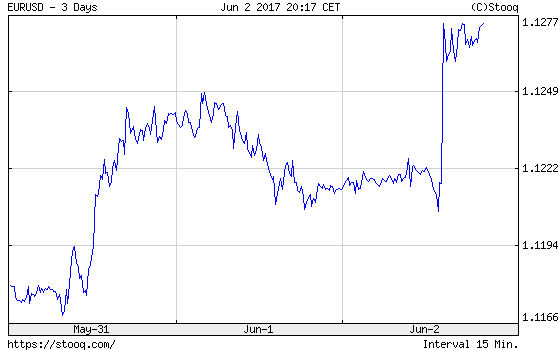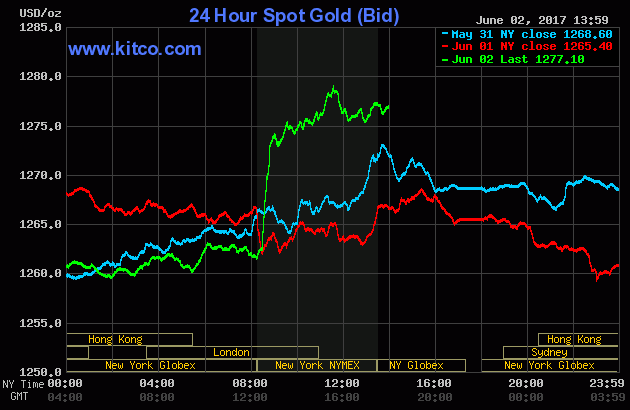May Payrolls And Gold

The US economy added only 138,000 jobs in May. What does it mean for the gold market?
Job Gains Weak In May
Total nonfarm payroll employment increased 138,000 in May, following an increase of 174,000 in April, according to the U.S. Bureau of Labor Statistics. Analysts had expected 185,000 jobs created. Thus, the actual number was significantly below expectations. Moreover, employment gains in March and April combined were 66,000 lower than previously reported. It’s a huge downward revision. It means that job gains in the last three months have only averaged 121,000, a big drop from 174,000 seen in the previous month.
The job gains were again concentrated in education and health services (+47,000), in professional and business services (+38,000), and in leisure and hospitality (+31,000). Government cut 9,000 jobs, while retail trade reduced 7,000 jobs.
Hence, job gains were weak in May, and the annual job growth rate remains in a downward trend, despite the recent rebound, as the chart below shows.
Chart 1: Total nonfarm payrolls (percent change from year ago) over the last five years.
Hence, the recent job gains may strengthen the dovish camp at the U.S. central bank and give the Fed reason to slowdown the pace of monetary tightening. However, the market odds of an upward move in June actually increased from 90 percent to 93.5 percent after the release of the employment situation report. Why? The reason may be that the unemployment rate decreased further.
Other Labor Market Indicators
Other labor market indicators were interpreted as positive, but the situation is more complex than the headlines may suggest. On the one hand, the average hourly earnings for all employees on private nonfarm payrolls rose by 4 cents to $26.22. It means that the hourly pay jumped 2.5 percent over the year. Moreover, the unemployment rate dropped from 4.4 percent to 4.3 percent, marking a new post-recession low.
However, the labor force participation rate declined from 62.9 to 62.7 percent, while the employment-population rate decreased from 60.2 percent to 60 percent. It means that the decline in the unemployment rate was caused by people leaving the labor force rather than by an increase in the number of people who found jobs.
Payrolls, Fed And Gold
In our opinion, the May report is disappointing. It’s a negative surprise after a strong ADP report released on Thursday. We know that a tight labor market makes it harder for companies to fill open vacancies, but the job gains were much worse than expected. Hence, it theoretically should be positive for gold. And indeed it was. The weaker-than-expected growth in the US payrolls put the greenback under downward pressure. The U.S. dollar plunged against the euro, as one can see in the chart below.
Chart 2: EUR/USD exchange rate over three last days.

Meanwhile, gold surged from $1,262 to above $1,275 immediately after the release of the report, as the chart below shows.
Chart 3: Gold prices over the last three days.

And this week may also be positive for the yellow metal (although some profit-taking may occur). The reason is the re-adjustment of market expectations of the future Fed stance. Although the June hike is seen as almost certain, investors took a third rate hike off the table. If the U.S. central bank raises interest rates, but signals more caution moving forward, gold may shine. This is at least what the recent history suggests – gold rallied after each ‘dovish’ hike in this tightening cycle.
Although the expectations of the Fed’s stance should be the key driver in the gold market, continued turmoil in Washington D.C. may also support gold prices this week. As a reminder, former FBI Director James Comey will testify before the Senate Intelligence Committee on Thursday. Stay tuned!
Disclaimer: Please note that the aim of the above analysis is to discuss the likely long-term impact of the featured phenomenon on the price of gold and this analysis does not indicate (nor does it aim to do so) whether gold is likely to move higher or lower in the short- or medium term. In order to determine the latter, many additional factors need to be considered (i.e. sentiment, chart patterns, cycles, indicators, ratios, self-similar patterns and more) and we are taking them into account (and discussing the short- and medium-term outlook) in our trading alerts.
********



















